![]() PETER VINCE
PETER VINCE
May 2006
![]()
The Beginning
| Back in 2004, the idea of this ride came
from a certain Terry Denham, a First World War buff, who thought it
would be 'different' for two ageing long distance cyclists to ride the
full length of the Western Front. I am a 63 year-old grumpy country
solicitor with three grandchildren and my riding companion of many
expeditions would be Nigel Petrie who lives at the bottom of a mountain
in North Wales and is nudging his 60th birthday.
The two of us had, since 1990, covered some 8000 biking miles - mainly along ancient pilgrim routes. By the flickering firelight of a Sussex country pub in the dead of winter 2004, Terry's plan seemed an exceedingly good idea. |
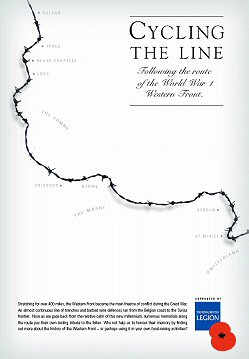 |
My first attempt at raising money by doing silly things had involved paddling a canoe the whole length of the River Ouse in Sussex to raise money for local ambulance equipment. Then I met Nigel and we rowed a hundred year old skiff from London to Oxford decked out 'à la Three Men in a Boat'. Then we cycled to Santiago de Compostela in north-western Spain from Bordeaux and then repeated that trip taking in the four different routes which fan out across Northern Europe to Santiago, the third most important pilgrimage destination after Jerusalem and Rome. Oh! And then we cycled from Rome to Canterbury.
Terry bought the maps covering the Swiss border to the Belgian coast and he devised the optimum route following as far as possible the historic line of the Western Front. He tried, however, to keep us away from main roads as much as possible and to ensure that we took in the major battlefield sites. In areas where the front was fluid, he steered us where possible down the middle line. However, the need to preserve our strength and find a hotel every night did mean some deviations would occur! What we discovered later was that a route for cyclists should be designed by cyclists as we did find ourselves climbing some horrible hills which I suspect could have been avoided!
We always undertake our long distance bike rides trying to raise money for one charity or another. It is a real pain persuading people to donate and then collecting the money but, at low moments on the actual trip, it is a great motivator to know that people have put their hard-earned money on you.
We were looking for a military charity and initially agreed with one such organisation that they would support the ride and we would raise money for their cause. They could, however, not get their act together and, a few months before we were intending to depart in May 2005, they pulled out. That was the excuse we needed to postpone the ride as we had by then realised how difficult it was going to be. Eventually Nigel negotiated with the Royal British Legion that they would allow us to ride under their flag - the poppy. This secured credibility for the ride in the eyes of sponsors and donors. A flight was arranged to Basel-Mulhouse on the Franco-Swiss border. Bikes were dismantled and packed in cardboard boxes and we had no further way out. Terry drove us to Heathrow and the adventure began!
Basel Airport is very modern with lots of glass and concrete and has a rather strange arrangement whereby you leave by one door through Swiss customs if you are going into Switzerland and another door via French Customs if you are going to France. We rather gained the impression that relations between the two countries were not all that cordial. Apparently Swiss taxis could not operate in France and vice versa. Nigel had pre-arranged a driver and 'people carrier' to take us the twenty-five miles or so from the airport to our overnight stop prior to the ride starting the next day, Friday 19th May - day one of our personal Ride of Remembrance.
DAY ONE - Is this a good idea?
It had taken a long time to find our hotel in the busy village of Seppois the night before, partially because the hotel had no name on it and partially because the village had a 'high bit' called Le Haut and a 'low bit' called Le Bas and we didn't know which bit was ours! Much confusion was added by the various people the taxi driver asked for directions and who gave conflicting instructions. Eventually, we found ourselves with no further motorised transport and two large cardboard boxes. All we had to do was bike home! The hotel was run by a youngish couple - he did the cooking (and did it very well) and she was the waitress/barmaid. She had a voluptuous figure and a saucy twinkle in her eye that I know was directed solely at me. Naturally, Nigel ruined it with a "the imagination plays tricks when you are far from home" comment!
I assembled my bike and tested it in no time at all and adjourned to the bar. Nigel joined me there in the time it took me to slurp two long stemmed glasses of Alsace white. I should warn readers that as much attention is paid in this journal to the needs and vagaries, the ins and outs, of our digestive tracts as to matters relating to the First World War. These aspects of the trip assume a great importance when there is not much else to think about.
We settled down to our dinner in the pretty hotel restaurant which I am sure had been designed with all its drapes and bits and bobs by 'She with the Twinkle in the Eye'. We had a plate of charcouterie followed by a man-sized plate of pasta tubes and boeuf bourguignon - really good preparatory food for 'a bit of a bike ride'. We were woken several times in the night and in the early morning by lorries driving from Le Bas to Le Haut right past our window. At dinner I had one of my many cunning plans.
| Pfetterhouse on the Swiss border is the southern extremity of the Front and was about four miles to the south of Seppois and we were going north. The plan was to leave our panniers at the hotel, ride to Pfetterhouse to start the ride and then collect the bags on the way through. Nigel reckoned, giving credit to Blackadder, that it was such a cunning plan that we could pin a tail on it and call it a weasel. |
|
Nigel had employed the services of a commercial designer to produce our publicity material and this included a laminated, double-sided A5 card bearing a diagram of our route and a description of the ride's purpose in English, French, German and Flemish. The plan was to lay one of these cards at war memorials, battle sites and war cemeteries along the way and we each carried fifty of them with plastic holders that we could stick into the ground if there was no other way of securing the card.
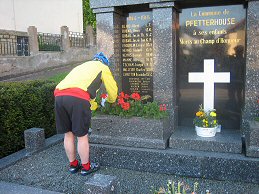
Our first memorial card
We dropped down into the neat, well-kept little town of Pfetterhouse by crossing a beautiful rolling landscape. I gave a splendid rendition of The Sound of Music that this countryside had evoked. A massive spired church stood on one side of the village square, a row of shops on the other and a big black polished granite war memorial stood to one side. No mention was made on the memorial that here was the beginning of the notorious Western Front. Pfetterhouse needs accommodation and it needs some indication of its historical importance!
You can see from some of the photographs that we had each strapped to the back of our bikes a poppy wreath. These weighed almost nothing but they certainly did get in the way from time to time. Why, I was even heard to mutter in frustration after packing to leave and forgetting the wreath - "B****y Thing!" I like to think that the wreaths contributed to the respect that most motorists showed us during the next nine days.
The time came for us to lay our first memorial card. By then there were twenty or so young children waiting for their school bus standing near us. They looked intrigued at the strangely dressed old men standing to attention in front of their war memorial. For the first time we said out loud the immortal fourth verse of the Laurence Binyon poem For the Fallen….
They shall not grow old as we who are left grow old
Age shall not weary them nor the years condemn
At the going down of the sun and in the morning
We will remember them
We were to say that nearly a hundred times more before the trip was over. We took turns and, when it was my turn, I frequently stumbled over the words. I so often felt that, at many of the places where we stood in our little act of remembrance, people hadn't remembered them.
It was now about half past eight and we enjoyed for the last time riding our bikes at break-neck speed back to Seppois without being burdened by luggage. Finally, after two years of planning and prevarication, we were off. Mrs Twinkle did not come out to say goodbye as we set off on our journey.
Apart from matters relating to the war and our bowels, two other major factors would influence our journey - map reading and the weather. We set off in rather blustery, cloudy weather but it was dry - more to the point the wind was from behind. Apart from village memorials, we were to see no sign of the first war during the early part of our trip. I am sure that there were signs there to be seen but, if so, we did not know of them. We had a long way to go in the short period of time and we could not see everything.
This brings me to one of Nigel's quaint habits - fixing a long distance bike ride and then, before we have turned a pedal, to start shaving time off the period allocated for the ride. On this occasion he was true to form and we were still in England when he indicated that we no longer had ten days for the trip but only eight! I reacted in my usual sweet natured but aggressive manner but then made no more of it knowing that he would almost certainly learn the hard way that what he was trying achieve was impossible. Neither of us were right.
|
|
The countryside between Seppois and Altkirch, as shown on the Michelin map, was marked by a heavy green line. That indicates a scenic road but to the cyclist it means one thing only and that is - Hills! The road swept up and down river valley after river valley and, it was so pretty, it really felt like being in an Alpine area. The houses had the look of Swiss chalets. |
No shops were open until we reached Hirtzbach and Nigel set off on his first foray for bananas - the essential energy food of the long distance cyclist. Hirtzbach has a very wide village street with a river running down the middle contained by high, stone walls. We put our second card on a roadside memorial but, when I looked at the picture of it on my return home, I think that the memorial had nothing to do with the war and was a crucifix with a religious inscription. I am sure nobody minded though.
We were much impressed here (and for most of the trip) with the number of farm animals kept in this part of Europe. Nowadays if a child in the UK sees a cow, he jumps up and down and points. Here there were thousands of them - mostly that lovely white sort (I'm not an expert. Can you tell?). We had a little section of main road to cover and then found ourselves crossing the River Rhin and heading north towards Thann.
Nigel had fitted to his bike a miniature video camera. In this early stage of the trip he took many pictures that show nicely what the countryside was like. It also shows nicely what a trim figure I am in lycra shorts! I hope that the e-version of this journal can contain some of the edited - or rather censored - parts of the film.
All that one can do if a lorry comes too close, apart from hope to survive, is to hurl abuse at it. It is very therapeutic to do so. Unfortunately, Nigel recorded some of these events on his little camera. As we puffed up a wee hill, the sun came out and the fields glowed green with splashes of colour from the wild flowers. Then the spell was broken by an ominous grey shape on the horizon - the Vosges Mountains!
At Thann we had a good lunch of rosti in a very busy little restaurant. We broke our rule of no alcoholic drink at lunchtime. Our legs didn't fall off that afternoon and so we afterwards always had a glass or two of plonk with lunch. The tourist office was closed at lunch time like they all are - just when they are needed - so we explored the magnificent collegiate church with its delicate lattice spire of the 15th century which looked much too frail to have survived for such a long time.
Knowing that we were approaching the mountains where there would be fewer and fewer places to stay, we arranged with the tourist office to carry on for another 25kms and they booked us into a hotel at Kruth. I can't remember who first said "Strewth, not Kruth!" However, fuelled by the rosti, we got on so well that afternoon that, when we arrived at Kruth, our hotel was still closed and it was only 4.30pm. We rode on knowing that there might be no other accommodation this side of the mountains that loomed larger and larger.
The map had all the giveaway signs of hard terrain ahead - little arrows (steep hills), view points (more steep hills) and scenic routes (even steeper hills).
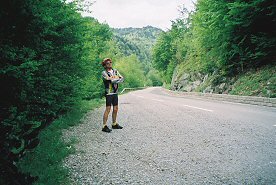
Have we really got to cycle up there?
By now my left knee was getting really painful. (Did I mention my arthritic left knee?). There was a little village on the map called Wildenstein and which was the last place before the mountains. At the top of the steep main street was a hotel. It was closed. Everything else was shut too except the national park office that I hoped would be their equivalent of a tourist office. A very helpful girl rang round the three places offering accommodation in the village and they were all closed. We imagined the horror of undoing all our hard work getting here from Strewth by having to go back! Then, joy of joys, we found a note pinned to the door of the Hotel du Soleil - "Ouvert a 18H." We waited and waited. The note could have been left when the hotel closed for the summer a month or so ago! We are now in ski resort territory. Nigel had a weasel of a plan and went round the back and found le patron. In three minutes flat we were supping beer to celebrate having knocked off well in excess of fifty miles on our first day. We felt some trepidation as to what lay ahead as the road map showed hairpin bends and a high point of 1,170 metres.
DAY TWO - The Vosges Mountains
On a grey, drizzly morning we set out before breakfast - which was our first mistake. We had not waited for the village shop to open to buy "fuel" so set off straight up the mountains. We were soon on the hairpin bends that were not too bad after all. There were about 300 yards between each bend and the climb was steady but unrelenting. Our old legs held up well but we began to suffer from lack of energy. On this trip time and time again we set off on a difficult section without food in our bags which is pathetic for experienced cyclists. Eventually we came to the mountain pass called the Col de Bramont - the gateway to a long series of ski resorts. We passed several closed ski hotels.
We had assumed that Bramont would be the highpoint of the day but that was not how it worked out. From Bramont, we dropped down a very sharp hill for about five miles - our hands were really cold and it was very difficult applying the brakes. The ski resort had the air of desolation that goes with an out of season resort. We could find nothing open to buy food. We were getting really hungry and cold. We stopped and I went into the best shelter I could find, which was a telephone box with a one foot gap around the bottom, and I put on another layer of clothing. We then set off up the most awful climb where they didn't even bother with hairpin bends. It just went up and up and up. Nigel by now had completely run out of fuel and had fallen way behind.
| After about five miles of this, we came to the top of the pass where it was pouring with rain and blowing a gale. Thankfully there was a large wooden chalet-like hotel at Collet which was actually open. We ate a huge sandwich each and had two large coffees. We spread our wet clothes on the radiators so at least they were warm when we put them back on. We then hurtled down a 20km stretch of road in the teeming rain. At the bottom of the climb we came to a nondescript little village called Fraize that - Glory Be! - had a restaurant. |
|
There we did lunch and it tasted so good. It consisted of a plate of local cold meats with salad and then a duck leg and homemade rosti potatoes and carrots. Anything would have been acceptable but this was wonderful food. We then squeezed into our revolting wet clothes and set out again. It was still pouring with rain and after a while we were forced to travel along the hard shoulder of what appeared to be a motorway. I then misread a sign that I thought meant 'bicycles this way' but it really meant ' no bicycles this way'. That added an extra five miles on our journey which we didn't need.
The first sign of grumpiness in the ranks arose. We got off the motorway and headed for the town centre of St Die des Vosges, quite an old town, but we were not in the mood to explore.
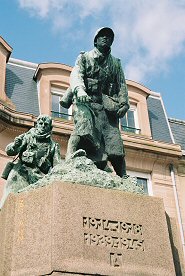
The memorial at St Die
The rain fell without a break. There was a monstrosity of a church built in red stone which was being worked upon and which was exceedingly gloomy inside. Some poor girl getting married there was struggling up the steps with her wedding dress getting all wet and horrible. What a terrible place to get married. We grabbed a coffee and got out of there. Then the weather started to improve a bit.
|
|
Now the big new road on the map was shadowed by its narrow predecessor so we kept to that. It was flat and we had the best cycling of the day. You could always tell when morale was improving because we started leaving our cards at village memorials etc. We found three nice little villages and left our cards and, at a place called La Vouvre, we found seven French war graves from the Great War in the village cemetery - complete with flag pole and flag. We left our calling card there. We tried throughout to hold our acts of remembrance at each nation's special places - not only those of the British. |
We then found the village war memorial in the same village that commemorated both world wars and there was reference to the village priest (who was 62) and another man of 73 who were shot by the Germans in the First World War. There is obviously an interesting story surrounding the little village of La Vouvre.
The mountains were now behind us and we calculated that we were a quarter of the way through the trip. This proved to be wrong as we had all along thought that the journey was about 400 miles - which was a gross underestimate. My fear was that the constant wind from the west would begin to hinder our progress as we turned more and more in a westerly direction. This day had been hard work, largely as a result of the rain and the mountains, but at least the wind was behind us. Once we were on the flat, we could sit there and let the wind blow us along. We had kept in touch with friends at home by sending text messages giving progress and Terry posted updates on the Great War Forum.
Raon L'Etape is a nice little town with a very dramatic war memorial that, at one end, has a copper representation of the Ossuary at Douamont and at the other, a plaque telling you that an urn full of earth from Douamont had been buried beneath the memorial. We learned later just how important to the French is the notorious battleground of Verdun. The hotel next to the memorial did not serve pression and we needed a beer after being told to carry our bikes up to the first floor for the night! So we wandered across to the bar over the village square and sank a few. There was a good restaurant in the hotel. The beer, the fatigue and the sixty plus miles prevents me from remembering more of that night.
I do remember that I was becoming worried about my wet, dirty clothes and being unable to dry anything. I was moaning about French hotels being too mean to turn on their bathroom radiators but that is unsurprising when they all have time switches on their hall and stair lights. I wonder how many unwary guests have fallen to a painful death upon being plunged into darkness at a crucial moment. I thought that was a very reasonable thing to moan about but the young lady who typed the first draft of this diary thought that I was being a bit of a wimp, taking account of the suffering hereabouts during the Great War. She has a point.
DAY THREE - Raon L'Etape - Pont à Mousson.
The day starts with beautiful but hilly countryside including dense forests for the first few miles and an occasional steep hill. Having set off at our regular time of 7am, our first stop was a village called Pexonne. There was a bric-a-brac market going on in the village square with the most incredible junk being offered for sale.
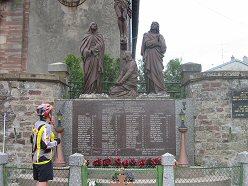
The memorial at Pexonne
The square had two war memorials and, upon further inspection, you could see that one was a second war memorial commemorating 65 civilians who were killed by the Gestapo in 1944 including the priest and the mayor. An additional tablet on this memorial referred to three English parachutists who were tortured and then burnt by the Gestapo.
| We bought two huge custard filled pastries for breakfast and ate them there and then before moving onwards and upwards. Nigel was pedalling well and I was taking my time a bit. My knee hurt. (Did I mention my arthritic knee?). The road tended to drop into small river valleys and then climb out of them - which is very annoying for cyclists - such a waste of effort! Eventually, at Montreux, I found the first sign that we were truly 'Cycling the Line'. A series of German concrete bunkers along a ridge overlooking the village bore a sign saying that trench systems were preserved in the locality. Unfortunately, Nigel had gone ahead and all I could do was take a few photographs and follow him. |
|
We covered forty miles before lunch then turned due west into the teeth of the wind as we passed through the very picturesque 'Parc Natural Regional de Lorraine'. Never have I seen so many acres of rapeseed growing. It is not everyone's idea of pretty scenery but it was at its most vivid stretching sometimes as far as the eye could see.
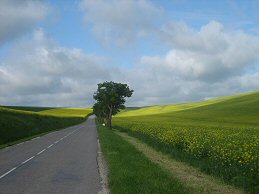
How many more miles to go?
At Lemoncourt, I made another rare mistake on the map and failed to notice that our route turned left. We went straight on down three miles of wonderful descent to a place called Delme and, after more trouble in the ranks, we had to climb back up the same three miles. Nigel didn't mind at all and he was very gentlemanly about it! (Oh Yeh?).
A few miles later I had the wonderful feeling of discarding map number one (of four) and moving on to map two - which was still depressingly far from home. We were still in the Moselle region and were still miles from Verdun and beyond. We were now heading straight into wind.
We were relieved to drop down into the town of Pont-à-Mousson for our overnight stop. This town had a massive twin-spired church alongside a very dramatic First World War memorial. We rang on the bell of a deserted looking hotel which was having its restaurant refurbished and, thank goodness, a nice man came to let us in and suggested that we carried our bikes up to the first floor (again!) - a bit hard on the leggies after 65 miles or so. We found an Italian restaurant and had a very passable plate of tagiatelle. Falling into very comfortable beds, we slept the sleep of the righteous as the River Moselle slid under the nearby bridge
DAY FOUR - Approaching Verdun
We left Pont-à-Mousson at about 7am and travelled about five feet before it started raining. We put on our wet gear and headed up the hill out of the town. The road now turned south-west, even more into the wind. We were coming to the Salient of St Mihiel in the Argonne where the war involved the Americans. At Thiaucourt, we found our first major war cemeteries. The first was at the top of a horrendous hill - a German cemetery with 17,000 occupants. It was a dour, miserable place. We recited Binyon's verse (Sad that it was only intended for the Brits). We then flew down the hill to the village and had a revolting coffee. All the shops were shut so we could not refuel. Nigel had, however, bought a few bananas in Pont-à-Mousson.
We found the American cemetery at Thiaucourt in the same village as the German cemetery. It seemed as though it had opened for business only the day before. It was as immaculate as their second war cemeteries I had previously visited in Normandy. Two massive flagpoles flew the Stars and Stripes. Enormous gilded gates and iron fences led to an office where we were made very welcome and to a reception room where we could sign the visitor's book. This was a carpeted room with a big desk and pictures all around of famous American Generals and Presidents. The Battle of the Argonne took place in the dying months of the war and many of the casualties had been killed in its last few days. We have all heard of the Ypres Salient but how many Brits know anything at all of the St Mihiel Salient?
At the far end of the cemetery is a chapel and inside is a vast mosaic work showing St Michael killing the dragon. The great bronze doors to the chapel had handles that were small representations of the heads and shoulders of American soldiers of the day. I noticed that their headgear had been polished bright by the palms of visitors. I recall that there are about 4,500 men resting there.
It was a strange contrast to the American chapel to find within half a mile a medieval church in Romanesque style with stone-vaulted ceilings all beautifully preserved. The church was dedicated to St Gorgon. Nigel did not seem to believe me when I told him that he was the patron saint of blue cheese!
The countryside was flat and open with lots of cattle and not too many hills. Mercifully, the wind was behind us. At Fresnes we had a wonderful lunch of spaghetti and followed it up with fruit tarts. The lady in the restaurant seemed to quite like us and we liked her too! We were now some fifteen miles or so due east of Verdun. Our original idea was to go straight into town, spend the night there and then do a tour of the battlefields to the north of the town the following day. However, having covered so much ground this day, we decided to do the tour before looking for our hotel in town.
|
|
The atmosphere of the battlefield was very
sombre. It had obviously been decided to forest the battlefield but, if
you peered into the dark recesses between the trees, you could still
see shell holes, trench lines and such like. Here was the killing
ground of France - the equivalent of our Flanders and the Somme but,
unlike in those areas, the villages had not been rebuilt. Time and
again we came to the site of a destroyed village, one of them, Fleury,
even had proper roadside names as though it still existed.
We then went to the Ossuary, set in an elevated position near Douaumont. It overlooked one of the biggest war cemeteries I can remember ever seeing. I have no idea how many crosses I could see but they seemed to stretch out to infinity. The mood of this area was very sobering. |
We bypassed the very interesting looking museum with artillery pieces around it simply because we couldn't stand the sound of the coach load of squawking kids. We parked our bikes outside the Ossuary and walked up the steps into this strange Art Deco style building. Inside, it consists of a vast corridor with side chapels. Each side chapel referred to a different area of France. As you entered the building, there in front of you was a large chapel with an inscription over the door referring to it as being for the use of Catholics and then naming, seemingly, every European country except Britain. Nigel commented that many thousands of British Roman Catholics must have fought and died alongside the French.
Terry had previously told me that around the back of the Ossuary at a lower level is a row of small square windows behind which one could see acres of stacked bones. 140,000 casualties rest here. We find the idea of ossuaries difficult to understand. They certainly save expense and don't take up much space but I am sure that many of the casualties' identities could have been known and now they are anonymous for all time. This is in contrast to our casualties having their name on a marked grave or on memorial to the missing.
We then trickled down a steep hill into the town of Verdun. We were tired and emotionally drained and could not be bothered to search for a suitable modest hotel. It was only about 6pm and the tourist office was open when needed for a change. They booked us into the best hotel in town. We removed our wet weather gear. The heavens opened and we got wetter in the last twenty yards that we had all day! Nigel found the bar before I did and was waiting with a large beer and a large scotch. We soon gave up trying to invent weak jokes and limericks about the name of the hotel, Le Coq Hardi.
DAY FIVE - To Reims - Unintentionally
This was to prove to be our longest day cycling. Not because we were particularly fit but because we couldn't find a hotel - of which more later. We left Verdun following the line of the River Meuse up a steep hill and then turned west through the battlefields fought over by the Americans. There were many memorials and we left many memorial cards. Several of the memorials had appalling casualty figures engraved on them as well as stories of great bravery and sacrifice. This was a good example of where we should have lingered and found out more about what happened here but we simply did not have the time.
We were now battling against a very stiff wind which is very demoralising for a cyclist. The countryside became more and more featureless with few trees and only nondescript hamlets to relieve the tedium. By now we wanted to stop as we had done sixty or more miles but there was nowhere big enough to support a bar let alone a hotel. Once again we ran out of food despite having every opportunity earlier in the day to buy food. I think it is a symptom of growing tiredness that one can hardly be bothered to do anything that is not essential.
It was early evening, around 7 o'clock, and at one road junction tempers got frayed. We had the choice of going into Reims, which never was the intention as the route passed to the North, or to follow the planned route to try and find accommodation at Reims Airport. The latter choice was my preferred option and we set out after Nigel had agreed to that route.
| I then rang a friend at home to ask if he knew the airport and whether there were any hotels there. He thought there were not and so we changed that plan and headed south towards the city centre of Reims. I had the guilty feeling that every hill was of my making!! We had done nearly ninety miles that day and by then were on automatic pilot. We came into the city centre and, even in that state, we were bowled over by the beauty of Reims Cathedral. There was no one around and the west front of the cathedral was bathed in a pink light from the setting sun. |
|
We could not find decent hotels anywhere and we were beginning to despair as it was nearly dark. Eventually I asked directions and was told that all hotels were in one area. We turned a corner and there were dozens of them! Before this, we had agreed to take a couple of rooms in a fairly rundown hotel quite near to the cathedral. As we discussed terms with the hotel owner, an Englishwoman, with much better schoolgirl French than my schoolboy French, interrupted us to strike up a conversation with the owner. We were kept waiting while she banged on about leaving early the next day. She then got her credit card out and started to pay. I made it quite plain to her how rude I thought she was and we both stomped off leaving le patron with two empty rooms thanks to her.
We finally chose a very posh Best Western Hotel in the city centre. It was very comfortable but we did feel remarkably out of place walking through the marble entrance hall as three haughty reception staff peered down their noses at these strange old creatures in their hotel. We flashed our credit cards at them and they relaxed a bit. The rooms were very comfortable but so they should have been.
DAY SIX - Headwinds on the Chemin des Dames
After having a very bland, watery Thai meal in Reims that night with very little conversation passing between us (mainly because there wasn't much left to say), we did exactly what I had hoped to avoid by attempting to overnight at the airport - riding at least three miles in circles around Reims trying to find the way out! The signposting was rubbish and, in the end, I had to rely on my compass. This duly brought us to the north of the city and up the hills that we had coasted down the day before. We didn't know it but there was a very difficult day awaiting us and the main culprit was the wind.
We eventually joined the 'D' road that headed towards the Chemin des Dames. First we came to a sweet little village called Hermonville and we saw the very first Commonwealth War Grave Commission sign of our trip.
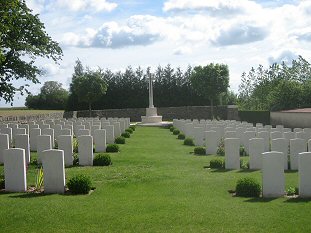
Hermonville Military Cemetery
There on the edge of the village was a small war cemetery and about half of the causalities seemed to be Unknowns. (I must find out what happened at Hermonville). The cemetery was beautifully kept and we left a card - our first British site.
From Hermonville, we clambered out of a steep sided valley, headed into the stiff headwind and battled with the three customary warning signs on the map - green stripes, viewpoints and uphill arrows. We could have avoided all that agony by following the N44 straight up towards Laon but it was still early days and we were being true to the Denham route. After we crossed the River Aisne, we began a steady and painful climb up to the eastern end of the Chemin des Dames. If anyone reading this knows the Hogs Back near Guildford in Surrey, then the Chemin des Dames is like that but three times longer and much higher. It runs east-west and is a notorious First World War location. It was along that road that Nigel and I struggled against an incessant headwind.
Along the whole length of the road, there are monuments and memorials, war cemeteries and caverns. We stopped at most of them but not at the Caverne du Dragon. Lengthy guided tours were the only way you could visit. The caverns eventually were occupied by the Germans who constructed a complete town below ground. At one stage during the Great War, the French occupied part of the caverns and the Germans another part with nothing but a thin wall between the two sections. I suppose the convenience and safety that the caverns afforded was so irresistible that the two armies allowed an informal truce to prevail whilst they were underground.
By now the headwind was fierce - probably at least twenty miles an hour and it was incredibly hard work making any progress. We stopped for a while at the monument to the Armies of The Basque Country. Any monument built on the top of a hill like this is much more dramatic than one on the flat. The Vimy Memorial and the Thiepval Memorial to the missing are similar examples. At Malval there were very interesting explanatory points which showed the history of the Chemin des Dames. We had about five more miles of this to do when one of my better ideas popped out.
Every mile or so was a road to our right dropping down in a northerly direction from the ridge road into the valley of the River Oise below. All we had to do to get out of the wind was abandon history and fly down an incredibly steep hill. We were immediately out of the wind, sheltered by the hill itself, and we then simply wound our way through peaceful meandering roads until we hit the main N2 road from Soissons to Laon. At this point we made an easy decision. It was getting late in the afternoon. It was beginning to rain and we were very tired. We had only done about fifty miles so far but it felt like double that. We decided there and then that we would put our backs to the wind, join the N2 and allow ourselves to be blown down a wide smooth road towards the town of Laon where we would spend the night.
Long experience had taught us that final destinations on our bike rides were never at the bottom of hill but invariably were perched on the highest point for miles. This was no exception to that rule and, as we stood at a busy roundabout on the southern ring road of Laon, we nearly got cricks in our necks looking up at the old town that was our destination. We were wet, tired and, strange to relate, my arthritic left knee (which I may have mentioned before) proved to be contagious. Nigel was in agony with his left knee! It will be well understood however that pride prevents one from walking up hills (unless nobody is watching) and so we set off up what is known technically as a 'ball-breaker'. It was probably a mile of twisting, turning road that finally brought us the wonderfully scenic gateways, ramparts and churches of our first stop in Picardy - the old town of Laon.
At the beginning of this trip we would arrive at a town. We would find a hotel, shower and change and if the fancy took us we would pop to the bar for a pre-dinner beer. The longer we went on, however, the more the ritual reversed itself. We had no thought of accommodation, no interest in washing or showering and just wanted to go somewhere warm and get some beer inside us. Laon is a university town but, despite this, the streets seemed particularly empty of life. We opened the door of the first bar we came to. It was heaving with students of both sexes - all of whom seemed to be smoking, even the pregnant ones. We soon forgot our aches and pains and, after about an hour, we wandered down the narrow, steep main street to a two-star hotel and a warm welcome from a young receptionist who was anxious to polish up his English by practising on us.
The hotel was perfect and very comfortable. The bikes had a good night too because the hotel owned a very cosy coffee bar which happened to be closed while we were there and it was the only time that our bikes rested on carpet for the night. The English student directed us through the pouring rain to a restaurant some fifty yards away. It was truly excellent and we had a wonderful meal. Who would have thought as we battled along the Chemin des Dames that three hours later we would be so pampered. By stopping in Laon we had strayed some distance north of the intended route but that did not trouble us one iota.
DAY SEVEN - Onwards with a Smelly Cheese
To my eternal shame I have no recollection of going to bed and my first thought was one of anguish the next day when I realised that all my washing that I had hung out of the window the night before was completely drenched and weighed a ton. To add to my worries, I had, two days earlier, purchased a Munster cheese that had an orange rind rather like a Pont L'Eveque but gradually outdid the most fruity Pont L'Eveque for the strength of its odour! Heaven knows what the chambermaid thought was wrong with me when she cleaned my room next day - sweaty socks and old Munster cheese. Perhaps the reason we never ate the cheese was that the bacteria in my old socks smelt identical to the bacteria in the cheese.
I decided the next day to secrete the Munster in one of Nigel's panniers. About an hour later when he thought I was not looking he put it back on my bike but in no time at all it was back on his. He did not find it again until the day was over.
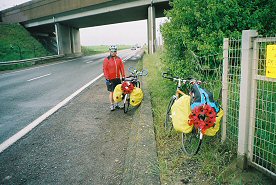
I'm sure I can smell that cheese
It was teeming with rain as we left Laon in our wet weather gear. After about twenty miles of pleasantly wooded, gently undulating countryside, we rejoined Terry's route at Danizy. It was Ascension Day in France and, rather like on Bastille Day, nearly everything closes. The boulangeries were open until mid-morning and after that there was nothing. We fairly flew along the 'D' road that followed the canal and River Sambre and so we entered St Quentin in time for lunch - were it not for the fact that that all the bars and all the restaurants were shut!
We were both pretty tired and bad tempered by then (again!) and we would be skating on very thin ice by risking much in the way of conversation. Fortunately, as in the UK, when everything closes for a religious or public holiday, the ethnic minority restaurant owners stayed open and cashed in. By now Nigel and I had third degree trench foot. I indicated earlier in this journal that there was a correlation between our degree of contentment and the number of memorial cards we laid at places on the way. Neither of us can remember laying any that day. I think we probably did but the protective quality of the human brain in deleting unpleasantness from its memory bank has left me with little recollection of that horrible day.
We turned west just north of St Quentin and headed towards Peronne. From here the British interest grew but first we needed to be dry, warm and refuelled. When we were at a low ebb in that way, we tended to book into the hotel with the most stars. We made that mistake at Peronne. The only three star hotel was L'Hotel des Ramparts. It was still raining. We were tired and grumpy still. We were greeted by a pleasant young lady - one who was obviously filling in for someone else as she knew absolutely nothing about checking guests into a hotel.
One of the many rules of long-distance biking is that the posher the hotel, the worse the accommodation for the bikes and here, for the first time on the trip, the bikes had to stay outside for the night in the rain. My room was pleasant enough and, with great relief, I ran a bath. It was cold. I called reception to complain. By then a man had arrived who was in charge of the establishment. He had a silly tuft of black hair sticking out of his chin. (I have always thought you either have a beard or you do not). He came into my room, put his hand under the running tap and assured me that it was hot. I lost my temper in Franglais and got absolutely nowhere. I finished up using Nigel's bath for a nice deep soak. (He had vacated it and I did have fresh water!). I was later put into an enormous room where the hot water was at least tepid. I was at a low ebb that night and it was good to have a phone call from home.
I joined Nigel in the bar and we quickly learnt that the technique was to order two drinks each while the going was good because the only two staff on duty were manning reception, were waiters, were bath water temperature gaugers and, you name it, they had to do it. That would have been fine had they performed their excessive duties with good grace but "Tufty" and his grumpy sidekick of a woman clearly very much resented the burden that was placed on them. The hotel restaurant was full. The service was sour and dreadful but the food when it came was very good. I urge any reader visiting Peronne to avoid this establishment. I did not have the presence of mind to secrete the Munster cheese in a place where it would never be found and thus secure revenge.
During the earlier part of that day in the wind and rain I tried very hard to unfold the map and check our whereabouts but every time I did so a lorry swept by and blew the map into a wet, flapping and quite useless piece of excess baggage. I think some of these incidents were captured in the audio visual record that Nigel was keeping. I remember on one occasion we realised that roughly two-thirds of the map included territory that we would not cover or would probably never see again and so I ripped that section off the map, screwed it up and threw it into an adjacent dyke where the wind took it away at a speed at least as fast we could cycle. (I don't normally litter the countryside but - OK. I plead guilty on this occasion). The next day we started on the last of our four maps as we entered the area of the Battle of the Somme.
DAY EIGHT - The Cavalry Arrives
|
|
After only a few miles we arrived at Maricourt on the Peronne-Albert Road. Had we continued and followed Terry's route we would have dropped down into Albert and then followed the course of the River Ancre, then through Serre and on to Arras. That route represented the British Line in July 1916, the infamous first part of the Battle of the Somme. We decided on the spot to follow a route as at the end of the battle in November but honesty dictates that we have to admit that we took that route because it was flatter and shorter. Sadly it would mean that we missed some sites very close to British hearts such as Lochnagar and Thiepval but time was becoming an important factor. |
This area may be heaving with British coaches, school parties etc. but to the locals it is fishing country. Many lakes and tributaries of the River Somme in this area are a paradise for anglers. About three miles out of Peronne, we stopped for our first coffee of the day. The local café was full of fisherman and there were many fishing items on sale with large containers of unsavoury looking fish bait - both alive and dead.
I am quite familiar with the Somme battlefield area and I was able at this point to give Nigel a running commentary on what happened to left and right as we headed north towards Longueval. The good news was that Terry and Jon Saunders (our 'support team') were due to join us this day in Nigel's four-wheel drive monster Land Cruiser Amazon - assuming Terry hadn't torn its roof off in the Eurotunnel train coming over that morning!
They would be staying with us for the rest of the ride once we met up with them. The " Dr Livingstone" experience eventually happened in the main street of Bapaume - unsurprisingly in the rain. After a merry meeting, we had to press on north through Arras as there was still a long way to go. We aimed to use the Arras ring road and then head up on minor roads to Vimy. It was still wet and windy. However, Jon had come fully equipped with a vacuum flask of piping hot, good old English tea that was gratefully accepted by the both of us.
At this point we sent Terry and Jon off on a voyage of discovery to find a MacDonalds. (I have never eaten a MacDonalds in my life but, such was the state of my depleted brain cells, that I had a sudden craving for one - and I was not even pregnant!). The story of their successful mission will have to wait and be told elsewhere but I believe that Jon's attempts to order four MacDonalds and chat up a French serving girl at the same time in Costa Brava Spanish will fill volumes just on its own.
Arras clearly could not be an overnight stop for us as it was in a river valley rather than on the top of a hill. We pulled up a pretty steep hill towards Vimy. Halfway up it was necessary to take a right turn to the village of Vimy rather than up to the Canadian Memorial on the crest of the ridge. I was not working well and Nigel went up ahead but made the fatal error which I later pompously called 'the cardinal sin' of passing a road junction and not knowing whether he was on the right route or not (He did not have a map). When I arrived at the junction I had no idea whether he had taken the correct turn or gone on ahead, so I stood there for forty minutes or so getting cold and wet and frustrated. He was not answering his mobile phone.
Eventually Terry turned up in the rescue ship and managed to find Nigel and bring him back to the right point - after they had all scoffed their luke-warm MacDonalds! To say the least I was uncharitable and unforgiving and my language was intemperate. Jon was visibly shocked. When Nigel did finally turn up he was so abused that he obviously felt he had no choice but to set off again on his own to get away from my tongue-lashing.
Terry must have wondered how on earth we had managed to do the first 450 miles without his help. Needless to say Nigel got lost again within a mile or so and once again Terry and Jon had to save the situation. We were finally reunited in Lens and normal cordial diplomatic relations were resumed. A list of the places which we were to pass through will suffice to show how close our route was to many of the major 'hot spots' of the war - La Bassée, Neuve Chapelle, Laventie, Armentières and so on. As we approached the motorway from Lille to the coast we really were suffering but were still determined to stop at every possible memorial to lay our memorial cards. These included the Portuguese cemetery and the many other British war cemeteries in the area. Terry and Jon did the same - quite legitimately claiming to be part of the ride 'team'.
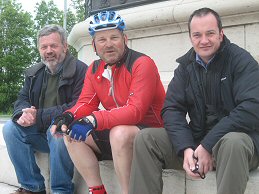
The support team supporting Nigel
Our support vehicle had gone on ahead to try to find overnight accommodation. They reported back at odd intervals that they were having no luck at all and that the very few hotels that seemed to exist were either shut or full up. We were most anxious to avoid going into the city of Lille knowing how long it would take us to get through the suburbs and how difficult it would be the next day to get out again. After much to-ing and fro-ing, Terry and Jon managed to book two rooms just across the Belgian border in Poperinge. However, as I hold a gold medal for snoring, my sharing a room with Nigel was out of the question. The vehicle set off once more to solve this problem.
Eventually, the 'team' bagged the last remaining hotel room in Bailleul - in France! I finished up drawing lots with Nigel as to who would stay in Poperinge and who in Bailleul. Terry remarked that we were taking our refusal to share rooms much too far by sleeping that night in different hotels, in different towns and in different countries! However, the three others were decent enough to share a meal with me in Bailleul before they set off for Poperinge.
DAY NINE - Is It Really Over?
Nigel's four-wheel drive arrived in the courtyard at the back of the hotel in Bailleul spot on time at 7am having driven from Pop. I had just finished oiling and checking his bike. Three car doors banged in the still, early morning air and I went 'sshhhh'. Nigel does not like being told to 'sshhhh' and it immediately put him in a grumpy mood. He then complained that I had not oiled his bike as I had promised the night before. I felt torn between wrapping the thing around his neck and just heading off for a bit of peace. You have to be really good friends to set out on one of these adventures and not let the inevitable abuse hit home!
The main road out of Baillieul took us in exactly the wrong direction. It was the only way to connect up to the road through Mesen and Ypres. I should have known better but I did actually get lost at that point but I was not communicating with Mr Grumpy and we finished up in Kemmel, a long way west of our intended route. Luckily Nigel did not look at the map and will not know until he reads this that he cycled twice as far as he should have that morning!
The café in Kemmel was closed so we flew into Ypres at a great speed on a flat bicycle track with the wind behind us, parked our bikes outside my favourite watering hole, The Old Tom, and had a couple of well earned beers. Our plan was to finish the ride at the Belgian coast and then come back by car to Ypres and spend the night there.
It was about 11am when we left Ypres and, by now, Terry was in his element as he and Jon were rushing off hither and thither to 'do some cemeteries' with Jon getting his first look at Ploegsteert Wood from the inside. I showed Nigel around Essex Farm Cemetery where we read out John McRae's poem which did make a pleasant change from our usual recitation which we had said nearly a hundred times at that stage.
Just past Boezinge we stumbled across a bike path which followed the Ijzer Canal up to Diksmuide and so we got off the main road and followed a slightly gritty but very flat path knowing that we had but ten or fifteen miles still to ride. It was Saturday morning and there were dozens of cyclists all in their lycras and on their lightweight bikes. It was quite unnerving to be overtaken every now and again by twenty or thirty of these going twice as fast as we were. At one point we stopped for a coffee and Nigel remarked that the group of cyclists that had just gone past were all in their seventies at the very least. By now we were running on automatic pilot again and not taking much in.
Terry and Jon had gone up ahead and found somewhere to eat in Diksmuide at lunchtime. We found ourselves on the wrong side of the canal but eventually joined them for a plate of omelette and chips which I had been fantasising about unsuccessfully since we had left Switzerland. After lunch we took the same bike track along the canal towards Nieuwpoort. Last lap adrenalin seemed to kick in at this point and we shot along like real cyclists showing a total disdain for the weight of our baggage.
On re-reading the above sentence, my ridiculously over-active sense of honesty kicked in and I now confess in public that all of the aforementioned wet, dirty and stinking clothes I had, the day before, put in a polythene bag and dumped in the back of the support vehicle. Nigel preferred to carry his. I feel so much better having made that confession and it will explain to Terry and Jon the source of that odd odour. (Oh! The other confession I have is that I left the Munster cheese in my hotel room in Bailleul - by accident!).
I am not sure what told them we were attempting a mammoth ride but, as we entered the outskirts of Nieuwpoort, and the bike path petered out, a group of cyclists applauded as we went by and said 'Well Done' in English. We then got lost again - half a mile from the finish! I knew that Terry and Jon were waiting for us at the British Nieuport Memorial adjacent to the Belgian Albert Memorial which marks roughly the northern end of the Western Front - and of our bike ride. We had been told to look for some wind turbine generators - and there they were! We arrived to the resounding applause of two lone Brits - our only reception committee. We had done it.
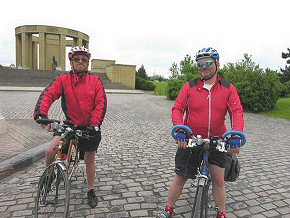
It's over at last! The arrival
A few photos were taken. We laid the slightly tired wreath that I had carried all that way from the Swiss border. We all said "They shall not grow old….." for the last time and that was it.
My body wanted to go on but only because the old thing had by now become hooked on its own self-generated painkillers. In no time flat the bikes were in the back of the Land Cruiser and we were heading back to Ypres.
| Terry had booked us into the Hotel Regina opposite the Cloth Hall. I had no trouble being kept awake by the bells and the fountain which normally keep visitors awake all night because I had been shoved into a small cupboard with a cheap shower in the corner in the innermost bowels of the hotel. Not for the first time the others had the best rooms with baths, a jacuzzi etc. and they very much enjoyed bragging about them for the rest of the evening. |
|
After some beers in The Old Tom, we went with a few hundred others to the Menin Gate. The Last Post Ceremony did not fail to move us all again - as ever. There was a lone piper who played a lament. Terry had organised many weeks previously with Jacky Platteeuw that we could, if we made it that far, lay a wreath during the ceremony. So, with about ten other servicemen or ex-servicemen, we laid our wreath - the one Nigel had carried from Switzerland.

The Menin Gate
Reveille was sounded. When you have the names of 54,000 missing men around you, it is a singular privilege to take part in such a moving ceremony. I will remember it and I will remember them.
We adjourned to The Old Tom for a magnificent meal and too many glasses of wine.
Conclusion
Riding the Western Front was completely new for us and I hope we are perhaps pioneers in what we would like to become a regular pilgrimage to keep 'Remembrance' alive. At the time of writing this we have reached a figure of just over £12,000 towards our intended purchase of three motorised wheelchairs for paraplegic servicemen. Maybe we will succeed in raising the full amount and get the final honour of presenting them to their recipients. Who knows?
I now know that there is a lot more to the Western Front than Flanders and the Somme and that other countries have their equivalent places of pilgrimage. Alsace, Lorraine, The Argonne, Verdun all taught me that there is so much more for me to learn about 'the War'.
Also I discovered that the Western Front is not 400 miles in length as I had calculated but was 542 miles!
When we rowed from London to Oxford all those years ago, we went back the next year and rowed the same route in the opposite direction. Maybe we will do that soon with the Western Front and hope in the process that the terrible headwinds will be on our side this time.
There are very few people in the lives of any of us with whom we can speak our minds without the restraint of politeness and good manners. We all need someone with whom and to whom we can be completely uninhibited when things get tough. Nigel Petrie is that person in my life. He can grump for England. He can sneer for Europe but by gum he is a great bloke to accompany you on a bit of a bike ride.
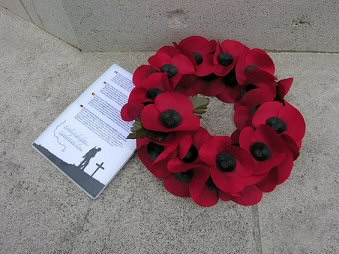
Remembrance - From Switzerland to Nieuwpoort
© Peter Vince July 2006
For a direct link to the author of this article, email Peter Vince
If you would like to contribute towards our intrepid cyclists' fundraising effort, you may make a donation via the Royal British Legion. To do this, just follow this link.
![]()
 Copyright © Peter Vince, July,
2006
Copyright © Peter Vince, July,
2006
Return to the Contents Section